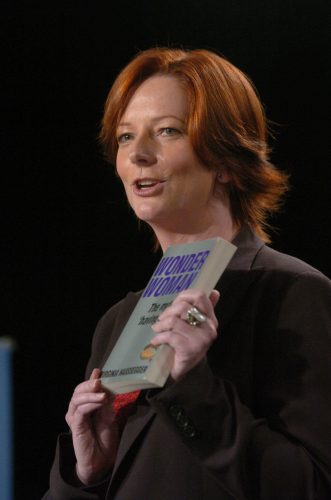What is going on with girls and young women? What has gone so terribly wrong that female self- loathing has reached such fever pitch?
How many Canberra girls pored over the school formal photos published during the week and recoiled with disgust? Too fat, too pale, bad hair, crap legs, fat arms, bad skin. And the inevitable, ”Oh- my-God, that looks, like, so gross.”
But the tirade of abuse isn’t a nasty attack on others. It’s personal. Deeply personal and thrashing around in many young girls’ heads. It’s all about the ”I”. Usually it starts with ”I’m fat”. Then ”I’ve got awful hair”, ”blotchy skin”, and we all know the rest: big bum, wrong-sized breasts, thin lips. In fact, why stop there? Cellulite thighs, thick, hairy legs, and even flat ugly toes.
There seems to be no end to the body failings of females. And there seems to be no girl or young woman who can’t reel off a comprehensive list of desired corrections.
Recently I listened dumbfounded as a sweet young thing explained to me the surgical mechanics of getting her toes elongated (made ”less pudgy” is how she put it), and her nose made skinnier. She was 13. But her biggest problem was, apparently, ”shifting fat”. I saw the kind of tummy I had at her age, a bit of puppy fat, with lovely soft skin. She saw an object of hate.
Sadly, shockingly, little Miss Pudgy Toes is far from alone.
Mission Australia this week issued its annual National Survey of Young Australians – 29,000 aged 11 to 24 were surveyed to find out what worries them, and where their priorities lie. It provides alarming reading. This year, for the first time, ”body image” rated as the top concern. For those aged 20 to 24, the level of that concern has doubled in the past 12 months. Not surprisingly, females out-worry males.
At first blush it might be easy to dismiss such findings as indicative of an increasingly vain and narcissistic youth culture, or a vapid and frivolous one. But that would be an oversimplification and a mistake.
The survey respondents rated ”family conflict” and ”coping with stress” as their second and third top concerns respectively. Like body image, these issues are very real and very prominent in their young lives. But the fact that body image has surpassed all else as their greatest concern, particularly among young women, should be a major concern for us all.
The head of Psychological Science at Latrobe University, Professor Susan Paxton, runs an online body- image program for teenage girls and says that while she’s not at all surprised by the survey results, she is ”startled” by the raw honesty.
Although a primary concern about body image doesn’t necessarily lead to an eating disorder, Paxton says it highlights a ”risk factor”. She says there is no hard evidence that illnesses such as anorexia are on the rise, but there is evidence it’s occurring at a younger age. Bulimia, on the other hand, is on the rise. Yet, research commissioned by Beyondblue suggests only one in 10 cases of bulimia are actually detected: indicating there are an awful lot of secret bulimics out there. The same research found 20 per cent of Australian women aged 18 to 22 have symptoms of Binge Eating Disorder. That means one in five young women are ”yo-yo” dieting: stuffing then starving themselves.
So what’s going on? Refreshingly, Paxton doesn’t simply blame ”the media”. Rather, she points to broader social pressures. ”The messages given to young people about the importance of their appearance can be quite toxic,” she says.
And those ”messages” come from everywhere: from friends, family, parents, the schoolyard, celebrity heroes, pop culture, music and all forms of advertising.
The high social value placed on appearance is unavoidable. But the current obsessive over-emphasis on a girl’s looks is happening largely at the expense of all other traits and talents. Girls are repeatedly told that being good, smart and hard working will ”get them places”, but what they experience is quite the contrary.
When they look at the world around them – on TV, in video clips, in films, magazines and online – they quickly learn that being attractive, pretty, sexy, and very thin, is really what gets a girl places. Or at least, to the most interesting and fun places.
The female celebrities who dominate the pages of Australia’s most popular women’s magazines may form a roll call of bad-mannered bimbos, but they all meet the universal criteria of what it is to be ”hot”. The sameness of their appearance has become a kind of code for all young women. A code to be copied.
Yet tragically, that code is increasingly shaped by sophisticated photographic and technological manipulation. As the criteria for what’s ”hot” and what’s not have narrowed, the code has become dramatically removed from reality, and therefore mostly unattainable. But that doesn’t stop every girl and young woman trying.
Some years ago I foolishly agreed to interview one of the world’s most overpaid supermodels. It was a humiliating experience. However, when I asked her if she ”felt beautiful”, she began by saying she was a ”genetic freak of nature”, which I assumed was an acknowledgment of her magnificent bone structure. She then went on to confess to a long list of grievances about her appearance.
Of course, none of her complaints were valid. But it was a stark reminder of how wilfully blind young women can be to their own beauty.
Mindful of this, I tried to think of something encouraging to say to Miss Pudgy Toes. I told her what beautiful long hair she had. She tossed her hair with a head flick and said very coolly, ”They’re extensions, same as Britney’s.”





